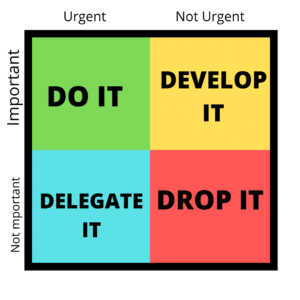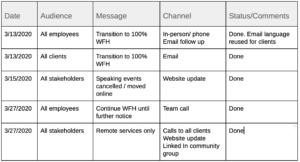What is Crisis Leadership?
First, let’s look at “crisis”. A crisis is defined as a condition of instability or danger, as in social, economic, political, or international affairs, leading to decisive change. In your business, a crisis can be internal or external and how you respond will raíse or lower both opportunity and threat of failure. What you do, how you do it and when you do it, more than any other time… matters.
Crisis Leadership is the collection of behaviors, actions, and resulting outcomes that move a business away from the point of instability. Our goal as leaders and change managers is to forge a path that creates opportunity and ongoing success for the businesses, organizations and teams that we lead.
Different Types of Crises
A crisis can be categorized as either internal or external in nature. An internal crisis may be caused by an unanticipated change in people, business processes, information or organization. The crisis comes from the fact that it wasn’t properly planned for – either because it couldn’t be predicted or we missed the signs that would have allowed us to mitigate the risk before it was an issue.
External crises are caused by sudden shifts in technology, finance, economics, health and safety, infrastructure and political systems. Again, the crisis is the result of not having a contingency plan in place, however generally speaking, external crises are more difficult to predict because we do not always have complete information on emergent issues that are outside of our immediate control.
If we’re being honest, most crises do have indicative signs before they trigger. Unfortunately, most of the time, we’re either looking at the wrong thing, or not looking for them at all.
So the question becomes, how do we adjust our lens to focus on what’s important rather than simply what’s urgent?
A Strategy for Managing Risk
Eisenhower is credited with the Urgent vs Important matrix and we can use it here to help triage the issues from the risks and manage the competing demands for our time.
1. It is both urgent and important: Do it.
These are typically the emergent issues that need to be addressed immediately. They are both critical to the business and urgent enough to require our attention. They may also be issues which cannot be delegated to others in the organization.
2. It is important but not urgent: Develop.
These are often risks which have been identified but have not yet become open issues. Or, they are important actions that need to be taken, but which are not yet ready to be implemented or which can wait until the immediate issues are handled. Keep them on the plan and develop mitigation strategies to address them.
3. It is urgent but not important. Delegate.
These are the activities that you may have handled yourself previously, but with increasing demands on your time and resources, now is the time to delegate. In fact, you should be delegating everything you possibly can now. When in doubt, try to find someone else to handle it. Your time is better spent on the important over the urgent.
4. It is neither urgent nor important. Drop.
This is the stuff that fills our days when we are not in a crisis – and it becomes absolutely nonsensical when we are. Get rid of it.
Creating the Business Continuity Plan
Your business continuity plan is the set of activities and resources that will ensure that your business continues to meet customer needs and brings in enough revenue to survive and eventually thrive. In some cases the business continuity plan is related to a change internal to the organization, for example a new systems implementation that has a job design impact.
People will need to be trained on new ways of working at the same time as the current operations are still ongoing. In other cases, the change is external to the organization – external market or economic factors that are forcing you to change all or part of your business model.
Externally driven change more often results in crisis management and continuity plans that are focused on business survival. They carry the greatest risk and require contingency plans as not all the variables are under your control.
Your business continuity plan will depend on your business, but there are some common elements that all plans should have. As Human Resources and Change Management Consultants, we focus on the people-driven strategies and plans that are outlined here.
1. A purpose or goal statement
You’ll need a statement that clearly outlines WHY you are doing what you’re doing. Simon Sinek advocates for starting with why when building a business; we believe that any change program, and especially disruptive change, MUST start with a clear statement of why, before tackling what, how or who.
2. A statement of your assumptions
It’s important to have a statement of your assumptions that you refer back to and will develop contingency plans for in case they are wrong. Make sure that your management teams are aware of the assumptions and have the ability to challenge them if the data doesn’t back them up or if the situation evolves and the assumptions are no longer valid
3. An organizational objective
Having an organizational objective that clearly articulates your strategy for retaining talent in a crisis is imperative. If the goal is to retain the entire organization in some form, be clear about it. Conversely, if there is a subset of the population that you need to retain at all costs, then state that. The goals set forth here will guide your decisions on layoffs later on.
4. A work plan
You should have a work plan that outlines what your business will deliver operationally during the crisis and how long you expect the crisis to last. This is particularly important, and hard to define, for externally driven crisis planning, so review and adjust your work plan and timing on a regular basis. There are many tools out there for work planning and tracking. We use monday.com internally and a range of software products when working with our clients.
5. A workforce plan
You should create a workforce plan that outlines which job roles and employees are essential to business operations. This may change as you move forward, particularly in a business survival plan, but start with a list of key jobs roles and the employees who have the critical knowledge, skills and experience to get the job done.
6. A compensation plan
Your business continuity plan should also include a compensation plan that clearly measures how long you can continue to pay your people based on work and workforce plans outlined above. Look at what compensation elements can be cut to make your cash last as long as possible and again, test your assumptions and refer to your organizational objectives when running scenarios.
7. A change and communication plan
Your continuity plan should also contain a change and communication plan that articulates how the change will be implemented to support the business goals (business survival or return on investment) and how communications will be developed and delivered – and WHO will deliver the messages – to support the change goals. Remember that every message in the communications plan needs to refer back to WHY we are doing this in the first place.
Driving Change as a Leader
Core Values
Change management, and crisis management in particular, is more likely to have a successful outcome if the decisions made that support that change are aligned with the company’s mission and core values. Core values describe the behaviors that employees and leaders exhibit in their day-to-day and that form the foundation of the company’s culture.
Conversely, crisis decisions that are made in the heat of the moment and that may tend to run counter-culture will have a greater negative impact than they would at other times. So the message is this: if you are struggling with some of the hard decisions that need to be made in a crisis, look to your core values for guidance.
People will remember how you treated them during this time. Be mindful of how you are communicating, interacting, and treating your employees. There is a unique opportunity to create long term employee engagement and loyalty through the actions and behaviors of leaders during times of crisis. Think about how we are ‘showing up’ and what we are asking our people to do. And, if we are asking our people to take a hit, make sure we are asking at least as much of ourselves.
Also, and often forgotten in times of crisis, be kind to yourself as a leader. Set appropriate boundaries to allow yourself time to rest and recover. Give yourself permission to wobble a little as you move through uncharted waters.
Communication Planning
Direct communications is always important when it comes to change management, but it is absolutely critical in a crisis. Authenticity comes from honesty – even in the face of difficult messages. As leaders, we don’t have all the answers and we need to be forthright in that message. Basically, if you can’t tell them, tell them when you can tell them.
We work with clients to create communication plans that outline what we are communicating to which audience, how, and when. It can be as simple as a spreadsheet with key messages, target audiences, dates, and how we’re putting it out there. We’ve included an extract of the communication planning we did when we shifted out consulting practice to 100% work for home on March 13th.
As a rule of thumb, we expect to have to communicate something five times before the message is correctly received and understood. In a crisis, the time available for that communication is shortened and the capacity of the audience to absorb information is reduced. So be sure to craft your messages in a way that it is easily understood and can be repeated without minimal distortion.
Communication planning is a critical part of an overall change management plan – especially when navigating a crisis. Sometimes an outside perspective can help. Red Clovver offers structured consulting support, communication plan development and templated plans to support organization as they navigate change and transition. Reach out to the team at Red Clover for more information on how we can help.
In our next article, we look at the role of human resources in crisis management and how it plays out over the employee lifecycle.
Written by Jen L’Estrange
Learn more about Jen on LinkedIn.





